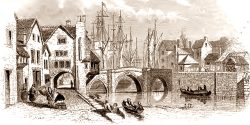The watercolours of John Chubb have an interesting afterlife as sets of lithograph prints.
In 1851 William Baker (1757-1853), FGS, the Bridgwater natural historian, wrote two papers for the Somersetshire Archaeological and Natural History Society (of which he was the first Honorary Secretary), on the High Cross and the Stone Bridge. These were illustrated by engravings by Thomas Harrison Hair, (1808 – 1875) who was most famous for depictions of industrial scenes in north-eastern England in the first half of the nineteenth century. By 1851 he was living and working in Taunton. (see Wikipedia for more about him).
These two illustrations are clearly based on the recently published series of lithographs on the old town, based on John Chubb’s paintings.


Comparison


It was noted in that edition of the Proceedings of the Somerset Archaeological and Natural History Society:
Mr. BAKER , by the kind permission of Colonel Tynte , presented the Museum of the Society with ten very rare prints illustrative of Old Bridgwater . The drawings were made by the late Mr. John Chubb , of that place , and were engraved at the expense of Colonel Tynte, for his own use.
With his permission , the Committee are enabled to enrich this volume with the very interesting views of the High Cross and Old Bridge in the second part . Mr. Baker has furnished a short notice of each , which will also be found there . (Proc. SANHS, Vol 1, 1853, p 32)
These engravings can no longer be found in the Society’s collection.
Also, in Chapter 20 of Jarman’s History of Bridgwater (1889) p.127, is also mentioned Colonel Kemmeys Tynte who died in November 1860 aged 82. He had been Bridgwater’s Member of Parliament for 6 parliaments. The passage says:
“… [Two presentations were ] from the inhabitants of Bridgwater, in March, 1858, and again in 1860, the year of his death. The presentation in 1858 was a noteworthy one. It took the form of a massive silver shield, valued at nearly £200, and was beautifully engraved with pictorial representations of the old stone bridge, St. Mary’s Church, the Cornhill, Market House, &c.; it was also inscribed to the effect that it was an offering to one who had faithfully represented the borough in six successive Parliaments.” …
The engravings were presumably based on Chubb’s illustrations of the old town. It is not known if the shield has survived. If so a photograph would be much appreciated.
When Tynte’s ‘engravings’ were exhibited to the society Hair’s two illustrations were presumably copied. These were sketched by T.H. Hair and engraved by ‘Jackson’ (as can be seen in the images above). Jackson is probably the noted engraved Mason Jackson (1819-1903). Hair and Jackson’s engravings enjoyed a slight afterlife. In about 1905 they were published as postcards by Page and Sons Printers of Bridgwater.
These may have been made using Hair and Jackson’s original print blocks, which, after being sold off from the SANHS apparently passed through various owners, turning up in Gloucester in 2014, then purchased by MKP in 2016. A third print block, of Barrington Court was with them, although this appears to be much later and not by Hair & Jackson. In the future they will be deposited in the Blake Museum, Bridgwater, to re-join the paintings upon which they are based.


Tony Woolrich, Miles Kerr-Peterson & Michelle Craig 13 December 2020
